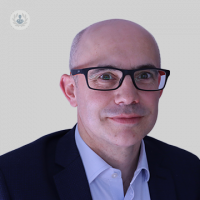Tummy tuck: What results can patients expect?
Written by:A tummy tuck, also known as an abdominoplasty, is a popular cosmetic surgical procedure to remove excess skin and fat from the tummy (the abdomen). This can improve the shape, the appearance, and the contour of the tummy.
Here to provide a comprehensive guide to a tummy tuck is Mr Sam Norton, a highly experienced Plastic and Reconstructive Surgeon. He explains when a tummy tuck might be considered, how a tummy tuck is performed, and what result a patient can expect, among other important points.

When might a tummy tuck be considered?
A tummy tuck might be considered for various reasons. Commonly, it is contemplated after pregnancy among women who may have redundant skin, fat, and sometimes stretch marks, on their tummies.
Often, a tummy tuck is also considered after weight loss. Similarly to pregnancy cases, weight loss leads to excess skin, fat, and stretched skin on the tummy that will not disappear even with exercise. By taking away this excess, the contour of the tummy can be improved. On some occasions, after both pregnancy and weight loss, the tummy wall may also need to be repaired. This is because of weakness, discomfort, and concerns with its appearance.
The last reason for considering a tummy tuck tends to be for scar improvement, where patients may have scars from previous surgeries or previous injuries. Sometimes, doing a tummy tuck can improve the appearance of these scars, by removing them, leaving scars that are mostly hidden under underwear.
What is the difference between a mini and a full (standard) tummy tuck?
A mini tummy tuck, contrary to what people might believe, is not a small operation. Tissue is still being removed from the tummy, but the amount of this tissue is smaller. As a result, the scar of a mini tummy tuck is shorter and located in the centre of the tummy (above where the pubic area is). In some cases, a scar around the belly button may be avoided by this approach if the tissue is pulled just right. This is usually achieved when a mini tummy tuck is performed for a less obvious skin problem. A mini tummy tuck is a more modest operation compared to a standard tummy tuck, but risks are still involved.
With a full tummy tuck, the amount of tissue being removed from the tummy is bigger. The resultant scars are also located from one hip to the other (right across the tummy), hidden along the underwear line, with another scar around the belly button. A full tummy tuck is a larger procedure than a mini tummy tuck.
How is a tummy tuck performed? Is liposuction involved?
A tummy tuck is normally performed under general anaesthetic, meaning that patients are asleep for the operation. There is usually, at least, one overnight hospital stay after the procedure.
During a tummy tuck, a cut is usually made from one hip to the other, along where the waistline (upper edge of underwear) would be. Skin and fat are pulled downwards, the extra tissue is taken away, and the scar is then hidden. At the same time, the tummy button is also repositioned. Sometimes, the tummy wall is repaired as well (where the muscles have relaxed in the middle). These muscles can also be reinforced to strengthen the tummy wall and improve the shape of the tummy.
In some cases, on top of this, liposuction is performed, which simply is a way of taking away unwanted fat using what is essentially a hollow needle. I personally will use liposuction on the sides of the tummy in particular (called the flank area), to try and improve the contour. In other cases, I will also use liposuction in other areas of the tummy where extra fatty tissue has accumulated, to smooth things out and achieve the best shape possible. Only one of these methods tends to be used at one time, but I often perform both, to achieve the most pleasing result at the end - all in a single operation.
The whole tummy tuck procedure takes, on average, around three hours.
When are results visible?
Immediately after a tummy tuck, there will be swelling, bruising, and soreness. After that, patients will be able to see the results of the procedure after about six to eight weeks, when the swelling has gone down and the scars are starting to mature (turning from bright pink, purple scars to paler scars).
On average, the end result of the tummy tuck will be visible after several months, but the complete healing process will take longer than that. The scars will gradually fade over a year, but at two months’ time following the tummy tuck, patients will be able to hide them under underwear. At two months’ time, patients will also be able to return to their normal routine, exercising and going back to their full working potential.
Will the abdomen be completely flat? How many sizes can be lost?
I never promise patients that the tummy will be completely flat, because this is very difficult to achieve unless a patient is very, very fit beforehand and only a small portion of skin is being taken away. Usually with time, there is naturally a little bit of relaxation of the tummy wall.
A tummy tuck targets the outside of the tummy wall, with the objective of improving its overall appearance and shape. In clothing, the tummy wall will be much improved after surgery; there is no skin overhang or excess, and this can help patients feel more confident. However, having a tummy tuck that is completely flat like a washboard is very difficult to achieve. This is why I normally tell patients that the overall contour will be better but won’t take them back to their youth.
Patients who had a rounded tummy prior to the tummy tuck should also know that this roundness will stay the same after the operation. This will certainly be the case if they are carrying a little extra weight as some of the weight will be below the tummy wall.
In terms of sizes, every body shape is different. For this reason, what needs to be done on an individual basis is to work out how much tissue could possibly be taken during the tummy tuck. The actual dress size is a difficult one to gauge, but give or take and even if a large amount of skin is removed, patients will only be able to wear more fitting clothes after surgery - not necessarily smaller-sized clothing. The result will be that they will at least look better in the clothing that they were wearing beforehand.
A tummy tuck is not a way to lose weight, it is not a quick fix. A tummy tuck is only a way of achieving an overall better contour and better body shape - once a patient is as healthy as they can be.
How long can the results of a tummy tuck last?
If a patient is at a good weight and in good health and a tummy tuck is then performed and the weight is maintained afterwards, then the results of a tummy tuck can last for five to 10 years.
If weight is lost after the procedure, or unfortunately, if weight is gained, then the results of a tummy tuck will change. This is why it is important to stay healthy after a tummy tuck and also prior to the operation, so that patients can get to the healthy weight they want to be at and be confident that the results of a tummy tuck will last for as long as possible.
Mr Sam Norton is a highly skilled plastic and reconstructive surgeon with more than 20 years of plastic surgical experience. If you are considering a tummy tuck and wish to discuss your options, do not hesitate to visit Mr Norton’s Top Doctors profile today.



